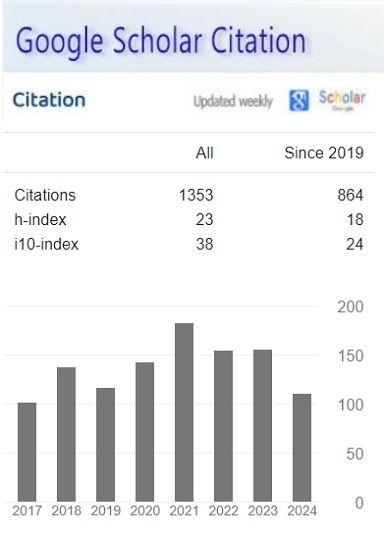AI-Driven Metabolic Engineering for Microbial Rubber Conversion: IT-enabled Strategies
Keywords:
Abstract
To improve efficiency and scalability, this study investigates the integration of artificial intelligence (AI) and IT-enabled techniques for the microbial conversion of rubber waste in metabolic engineering. The primary goals are to build synthetic biology constructs for enhanced rubber degradation, optimize bioprocess parameters through IT techniques, and use computational tools for route optimization. Methodologically, the study synthesizes insights from AI-driven techniques and IT-enabled procedures through an extensive analysis of existing literature and secondary data sources. Notable discoveries underscore the progress made in synthetic biology design, bioprocess optimization, and pathway prediction, highlighting the transformative potential of AI-driven metabolic engineering for sustainably produced rubber. The consequences of the policy include the need for more funding for research infrastructure, capacity building, and regulatory monitoring to enable the ethical use and responsible deployment of AI technologies in biotechnology and to remove any technological implementation impediments. This work advances sustainable approaches to resource recovery and waste management for rubber, tackles global environmental issues, and advances the circular economy goal.
References
Baritugo, K-A., Kim, H. T., Yokimiko, D., Choi, J-i., Hong, S. H. (2018). Metabolic Engineering of Corynebacterium Glutamicum for Fermentative Production of Chemicals in Biorefinery. Applied Microbiology and Biotechnology, 1-23. https://doi.org/10.1007/s00253-018-8896-6 DOI: https://doi.org/10.1007/s00253-018-8896-6
Davies, F. K., Jinkerson, R. E., Posewitz, M. C. (2015). Toward a Photosynthetic Microbial Platform for Terpenoid Engineering. Photosynthesis Research, 123(3), 265-284. https://doi.org/10.1007/s11120-014-9979-6 DOI: https://doi.org/10.1007/s11120-014-9979-6
He, R., Yang, K., Li, Z., Schädler, M., Yang, W. (2017). Effects of Forest Conversion on Soil Microbial Communities Depend on Soil Layer on the Eastern Tibetan Plateau of China. PLoS One, 12(10), e0186053. https://doi.org/10.1371/journal.pone.0186053 DOI: https://doi.org/10.1371/journal.pone.0186053
Li, M., Nian, R., Xian, M., Zhang, H. (2018). Metabolic Engineering for the Production of Isoprene and Isopentenol by Escherichia Coli. Applied Microbiology and Biotechnology, 102(18), 7725-7738. https://doi.org/10.1007/s00253-018-9200-5 DOI: https://doi.org/10.1007/s00253-018-9200-5
Mohammed, M. A., Mohammed, R., Pasam, P., Addimulam, S. (2018). Robot-Assisted Quality Control in the United States Rubber Industry: Challenges and Opportunities. ABC Journal of Advanced Research, 7(2), 151-162. DOI: https://doi.org/10.18034/abcjar.v7i2.755
Müller, M. M., Hausmann, R. (2011). Regulatory and Metabolic Network of Rhamnolipid Biosynthesis: Traditional and Advanced Engineering Towards Biotechnological Production. Applied Microbiology and Biotechnology, 91(2), 251-64. https://doi.org/10.1007/s00253-011-3368-2 DOI: https://doi.org/10.1007/s00253-011-3368-2
Nizamuddin, M., Natakam, V. M., Sachani, D. K., Vennapusa, S. C. R., Addimulam, S., & Mullangi, K. (2019). The Paradox of Retail Automation: How Self-Checkout Convenience Contrasts with Loyalty to Human Cashiers. Asian Journal of Humanity, Art and Literature, 6(2), 219-232. https://doi.org/10.18034/ajhal.v6i2.751 DOI: https://doi.org/10.18034/ajhal.v6i2.751
Pydipalli, R. (2018). Network-Based Approaches in Bioinformatics and Cheminformatics: Leveraging IT for Insights. ABC Journal of Advanced Research, 7(2), 139-150. https://doi.org/10.18034/abcjar.v7i2.743 DOI: https://doi.org/10.18034/abcjar.v7i2.743
Pydipalli, R., & Tejani, J. G. (2019). A Comparative Study of Rubber Polymerization Methods: Vulcanization vs. Thermoplastic Processing. Technology & Management Review, 4, 36-48. https://upright.pub/index.php/tmr/article/view/132
Richardson, N., Pydipalli, R., Maddula, S. S., Anumandla, S. K. R., & Vamsi Krishna Yarlagadda. (2019). Role-Based Access Control in SAS Programming: Enhancing Security and Authorization. International Journal of Reciprocal Symmetry and Theoretical Physics, 6, 31-42. https://upright.pub/index.php/ijrstp/article/view/133
Rodriguez, M., Tejani, J. G., Pydipalli, R., & Patel, B. (2018). Bioinformatics Algorithms for Molecular Docking: IT and Chemistry Synergy. Asia Pacific Journal of Energy and Environment, 5(2), 113-122. https://doi.org/10.18034/apjee.v5i2.742 DOI: https://doi.org/10.18034/apjee.v5i2.742
Sachani, D. K. (2018). Technological Advancements in Retail Kiosks: Enhancing Operational Efficiency and Consumer Engagement. American Journal of Trade and Policy, 5(3), 161–168. https://doi.org/10.18034/ajtp.v5i3.714 DOI: https://doi.org/10.18034/ajtp.v5i3.714
Tejani, J. G. (2017). Thermoplastic Elastomers: Emerging Trends and Applications in Rubber Manufacturing. Global Disclosure of Economics and Business, 6(2), 133-144. https://doi.org/10.18034/gdeb.v6i2.737 DOI: https://doi.org/10.18034/gdeb.v6i2.737
Tejani, J. G. (2019). Innovative Approaches to Recycling Rubber Waste in the United States. ABC Research Alert, 7(3), 181–192. https://doi.org/10.18034/ra.v7i3.660 DOI: https://doi.org/10.18034/ra.v7i3.660
Tejani, J., Shah, R., Vaghela, H., Kukadiya, T., Pathan, A. A. (2018). Conditional Optimization of Displacement Synthesis for Pioneered ZnS Nanostructures. Journal of Nanotechnology & Advanced Materials, 6(1), 1-7. https://www.naturalspublishing.com/Article.asp?ArtcID=13193
Wang, J., Shen, X., Rey, J., Yuan, Q., Yan, Y. (2018). Recent Advances in Microbial Production of Aromatic Natural Products and their Derivatives. Applied Microbiology and Biotechnology, 102(1), 47-61. https://doi.org/10.1007/s00253-017-8599-4 DOI: https://doi.org/10.1007/s00253-017-8599-4
Yarlagadda, V. K., & Pydipalli, R. (2018). Secure Programming with SAS: Mitigating Risks and Protecting Data Integrity. Engineering International, 6(2), 211–222. https://doi.org/10.18034/ei.v6i2.709 DOI: https://doi.org/10.18034/ei.v6i2.709
Zhang, H., Liu, Q., Cao, Y., Feng, X., Zheng, Y. (2014). Microbial Production of Sabinene--A new Terpene-based Precursor of Advanced Biofuel. Microbial Cell Factories, 13(20). https://doi.org/10.1186/1475-2859-13-20 DOI: https://doi.org/10.1186/1475-2859-13-20
Zheng, Y-n., Li, L-z., Xian, M., Ma, Y-j., Yang, J-m. (2009). Problems With the Microbial Production of Butanol. Journal of Industrial Microbiology & Biotechnology, 36(9), 1127-38. https://doi.org/10.1007/s10295-009-0609-9 DOI: https://doi.org/10.1007/s10295-009-0609-9
Downloads
Published
How to Cite
Issue
Section
License
Copyright (c) 2020 Asian Journal of Applied Science and Engineering

This work is licensed under a Creative Commons Attribution-NonCommercial 4.0 International License.








